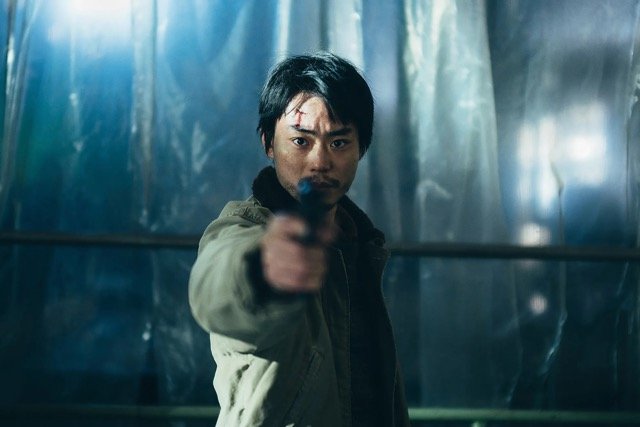The Terror of Godzilla Minus One
The bomb and the sea. These elements have shaped Japan’s storytelling in profound ways since World War II, never more deliberately than in Toho’s Godzilla series of films. Godzilla—the movie or the monster—has never targeted subtlety, so it’s fitting that the latest in the long running series, Takashi Yamazaki’s Godzilla Minus One, opens on a Japanese fighter pilot gliding over the waves to a lone island, a bomb fastened to the undercarriage in short focus.
That fighter pilot, Koichi (Ryunosuke Kamiki), is trying to escape the bomb. Tasked with a kamikaze mission but unwilling to end his life, he feigned a mechanical issue and deviated to this island for repairs. Neither the sea or the bomb are so easy to escape, however. The war haunts him, as does the sting of his felt cowardice.
Koichi’s attempts to rebuild mirror those of Japan as a whole. Lament is followed by survival, and flourishing soon appears on the horizon. But before long, the monster appears there, as well, threatening to both dredge up the destruction of the war and bring to ruin all the hope that has since been cultivated.
Godzilla Minus One understands its inherited legacy, but it manages to find a contemporary edge. More impressively, it manages to make Godzilla—a monster immortalized in pop culture around the world—feel terrifying and localized. Across the decades, this creature has represented atomic fears and become a beneficent (if begrudging) protector of the Japanese islands. It has also cross-pollinated with Western entertainment that has widely stripped it of its figurative potency for the baser thrills of watching cities get destroyed.
This Godzilla is nothing except awe and unanticipated terror. An engrossing oner opens the action mere minutes into the film: there’s no slow rise of the monster from the waves or searching the darkness for glimpses of a predator; a searchlight flicks on and Godzilla is there in full view. It angers, and in the next instant the searchlight, guard tower, and guard are gone. Men are crushed, bludgeoned, severed, and thrown hundreds of feet. It is momentary, relentless, and fully destructive.
Yamazaki never lets the fun of Godzilla mask the human cost, broadening the symbolism beyond the bombings of Hiroshima and Nagasaki to encompass the totality of war. Like war, this monster is opposed to the full scope of the human endeavor. As one character laments, Japan has “treated life far too poorly.” With acute anger, Minus One questions the methods and means of war. A heroism that merely commits suicide against an unstoppable devastation is futile. In its way, Minus One is the other side of Oppenheimer’s coin. One traces how our pursuits too easily allow us to fall into war. The other shows how our wars, and the unprecedented destruction of them, follow us long after.
The most intelligent aspect of Yamazaki’s direction is to cast the encounters with Godzilla from the perspective of those who suffer its cataclysm. His is a subjective view of Godzilla. Unlike many Western iterations, this subjectivity doesn’t mean hiding the creature or quick, glancing action or a shaky, obstructed lens. We mostly see Godzilla in full, thus see the full extent of its power. But we live, always, with the humans caught between fear and wonder. We live on the ground with them in the last flickering moments when their impulses to survive still matter.
This quality acts as a mimesis for a subjective view of war. Momentary. Relentless. Fully destructive. Godzilla Minus One doesn’t hate Godzilla, but it hates the war(s) that Godzilla embodies. The animating spirit of the movie, voiced by Noriko (Minami Hamabe), is a questioning one: “Is your war finally over?” For Koichi and the other Japanese characters, their war has followed them, overshadowed the hope that was just beginning to blossom.
All this and I’ve hardly mentioned the action: It’s superb. Godzilla is as horrifying as it’s ever been, and mean, at that. Yamazaki handles the monster’s powers with dexterity and a clear vision, while stopping shy of deifying them. Godzilla’s heat ray is particularly frightening and sudden, no matter how many times it occurs. Godzilla charges up, stirring our awe, but the actual annihilation occurs with a jarring twitch of the head. It’s unpredictable; it’s the final word.
Godzilla Minus One is technically impressive in many aspects. The camera casts the sea as a mystic landscape. The sound editing is atomic in incision and power: Silence dampens the chaos as the score fills the space, until a howl—of human or monster origin—shatters the calm. Insert shots come sudden and sharp, dislodging us from any sense of security that was never really there to begin with. (We aren’t safe—Godzilla Minus One is aware but ruthless about the attachment we form to its characters.)
In its reflections on war, Godzilla Minus One weighs different forms of sacrifice. Kamikaze devotion to empire is counterposed to compassionate giving of one’s safety for the sake of others. Just as Godzilla acts as a symbol, so does Koichi. Perhaps our nations can figure out some new form of bravery, one that casts off the shackles of pointless nationalism and finds life in the relationships we have with others. There is, just maybe, something worth fighting and sacrificing for.



